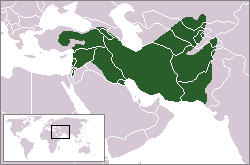
Back Seleukidiese Ryk Afrikaans Seleukiden ALS سلوقيون Arabic امبراطوريه سلوقيه ARZ Imperiu seléucida AST Selevkilər imperiyası Azerbaijani سلوکیلر ایمپیراتورلوغو AZB Селевкиҙар дәүләте Bashkir Дзяржава Селеўкідаў Byelorussian Імпэрыя Сэлеўкідаў BE-X-OLD
Kekaisaran Seleukia Ἀρχή Σελεύκεια Arche Seleύkeia | |||||||||||||||||||
|---|---|---|---|---|---|---|---|---|---|---|---|---|---|---|---|---|---|---|---|
| 312 SM–63 SM | |||||||||||||||||||
 Wilayah terluas Kekaisaran Seleukia. | |||||||||||||||||||
| Status | Kerajaan Diadokhoi | ||||||||||||||||||
| Ibu kota | Seleukia di Tigris (305–240 SM) Antiokhia (240–64 SM) | ||||||||||||||||||
| Bahasa yang umum digunakan | Yunani, Persia | ||||||||||||||||||
| Agama | Olympianisme | ||||||||||||||||||
| Pemerintahan | Monarki | ||||||||||||||||||
| Raja | |||||||||||||||||||
• 305–281 SM | Seleukos I Nikator | ||||||||||||||||||
• 65–63 SM | Philippos II Philoromaios | ||||||||||||||||||
| Era Sejarah | Helenistik | ||||||||||||||||||
• Didirikan | 312 SM | ||||||||||||||||||
| 64 SM | |||||||||||||||||||
• Raja terakhir dikalahkan; Suriah menjadi provinsi Romawi | 63 SM | ||||||||||||||||||
| Luas | |||||||||||||||||||
| 301 BC[1] | 3.000.000 km2 (1.200.000 sq mi) | ||||||||||||||||||
| 240 SM[1] | 2.600.000 km2 (1.000.000 sq mi) | ||||||||||||||||||
| 175 SM[1] | 800.000 km2 (310.000 sq mi) | ||||||||||||||||||
| 100 Sm [1] | 100.000 km2 (39.000 sq mi) | ||||||||||||||||||
| |||||||||||||||||||
Bagian dari seri mengenai |
|---|
| Sejarah Iran |
 |
Kekaisaran Seleukia (bahasa Yunani: Σελεύκεια, Seleύkeia) adalah negara Yunani-Makedonia yang terbentuk melalui penaklukan Aleksander Agung.[2][3][4][5] Pada puncak kejayaannya, kekaisaran ini meliputi Anatolia tengah, Levant, Mesopotamia, Persia, dan juga Turkmenistan, Pamir serta sebagian Pakistan modern.
Keaisaran Seleukia merupakan pusat penting kebudayaan Helenistik yang menjaga keberlangsungan adat Yunani dan tempat elit politik Yunani-Makedonia mendominasi, sebagian besar di daerah perkotaan.[5][6][7][8] Populasi Yunani di kota-kota yang menjadi elit dominan merupakan para emigran dari Yunani.[5][6] Ekspansi Seleukia ke Anatolai dan Yunani secara tiba-tiba terhenti setelah kekalahan Seleukia oleh pasukan Romawi. Usaha mereka untuk mengalahkan musuh bebuyutan mereka Mesir Ptolemaik dipersulit oleh tuntutan-tuntutan Romawi. Sebagian besar wilayah kekaisaran ditaklukan oleh bangsa Parthia di bawah Mithridates I dari Parthia pada pertengahan abad ke-2 SM, tetapi para raja Seleukia terus memerintah wilayah yang kecil di Suriah hingga invasi oleh raja Armenia Tigranes yang Agung dan akhirnya Seleukia diruntuhkan oleh jenderal Romawi Pompeius.
- ^ a b c d Taagepera, Rein (1979). "Size and Duration of Empires: Growth-Decline Curves, 600 B.C. to 600 A.D". Social Science History. 3 (3/4): 115–138. doi:10.2307/1170959. JSTOR 1170959.
- ^ Jones, Kenneth Raymond (2006). Provincial reactions to Roman imperialism: the aftermath of the Jewish revolt, A.D. 66-70, Parts 66-70. University of California, Berkeley. hlm. 174. ISBN 9780542824739.
... and the Greeks, or at least the Greco-Macedonian Seleucid Empire, replace the Persians as the Easterners.
- ^ Society for the Promotion of Hellenic Studies (London, England) (1993). The Journal of Hellenic studies, Volumes 113-114. Society for the Promotion of Hellenic Studies. hlm. 211.
The Seleucid kingdom has traditionally been regarded as basically a Greco-Macedonian state and its rulers thought of as successors to Alexander.
- ^ Baskin, Judith R. ; Seeskin, Kenneth (2010). The Cambridge Guide to Jewish History, Religion, and Culture. Cambridge University Press. hlm. 37. ISBN 9780521689748.
The wars between the two most prominent Greek dynasties, the Ptolemies of Egypt and the Seleucids of Syria, unalterably change the history of the land of Israel…As a result the land of Israel became part of the empire of the Syrian Greek Seleucids.
- ^ a b c Glubb, Sir John Bagot (1967). Syria, Lebanon, Jordan. Thames & Hudson. hlm. 34. OCLC 585939.
In addition to the court and the army, Syrian cities were full of Greek businessmen, many of them pure Greeks from Greece. The senior posts in the civil service were also held by Greeks. Although the Ptolemies and the Seleucids were perpetual rivals, both dynasties were Greek and ruled by means of Greek officials and Greek soldiers. Both governmennts made great efforts to attract immigrants from Greece, thereby adding yet another racial element to the population.
- ^ a b Steven C. Hause, William S. Maltby (2004). Western civilization: a history of European society. Thomson Wadsworth. hlm. 76. ISBN 9780534621643.
The Greco-Macedonian Elite. The Seleucids respected the cultural and religious sensibilities of their subjects but preferred to rely on Greek or Macedonian soldiers and administrators for the day-to-day business of governing. The Greek population of the cities, reinforced until the second century BCE by emigration from Greece, formed a dominant, although not especially cohesive, elite.
- ^ Victor, Royce M. (2010). Colonial education and class formation in early Judaism: a postcolonial reading. Continuum International Publishing Group. hlm. 55. ISBN 9780567247193.
Like other Hellenistic kings, the Seleucids ruled with the help of their “friends” and a Greco-Macedonian elite class separate from the native populations whom they governed.
- ^ Britannica, Seleucid kingdom, 2008, O.Ed.
© MMXXIII Rich X Search. We shall prevail. All rights reserved. Rich X Search

